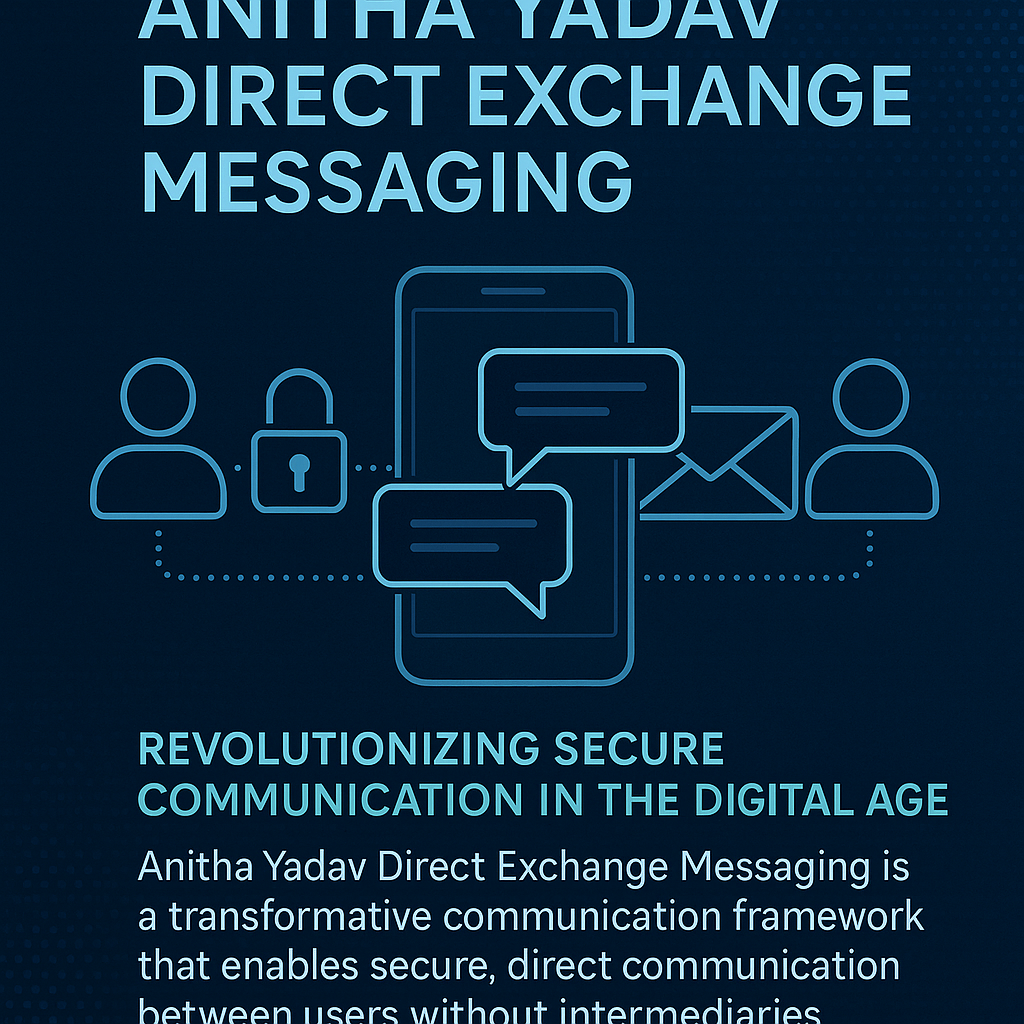Introduction to Anitha Yadav Direct Exchange Messaging
The modern digital landscape demands communication systems that are fast, reliable, and secure. In this context, Anitha Yadav Direct Exchange Messaging (AYDEM) emerges as a transformative communication framework that seeks to streamline direct communication between users, organizations, and systems without intermediaries. Named after Anitha Yadav, a pioneer in secure communications technology, this model shifts the paradigm of how information is transmitted and protected in today’s interconnected world.
The Historical Context and Foundations of the Concept of Anitha Yadav Direct Exchange Messaging
The roots of AYDEM trace back to the evolution of decentralized communications. In the early 2010s, concerns about data breaches, corporate surveillance, and inefficiencies in traditional messaging systems led researchers like Anitha Yadav to explore more autonomous frameworks. Drawing inspiration from peer-to-peer networking, blockchain, and secure socket layer protocols, the AYDEM model was conceptualized to eliminate third-party vulnerabilities and establish a more transparent channel for communication.
Fundamental Technology Underpinning Direct Exchange Messaging
Anitha Yadav’s model is built on a suite of core technologies:
- End-to-End Encryption: Every message is encrypted at the sender’s end and only decrypted at the receiver’s end.
- Peer-to-Peer Architecture: AYDEM leverages a direct node-to-node structure that avoids central servers.
- Identity Verification via Public Key Infrastructure (PKI): Ensures authenticity and integrity through cryptographic key pairs.
- Decentralized Hash Chains: Inspired by blockchain, they verify the chronological integrity of message exchanges.
- AI-Powered Traffic Optimization: Intelligent routing to reduce latency and ensure optimal bandwidth usage.
Applications Across Various Sectors
AYDEM’s model is not restricted to personal communication. Its scalability allows for applications across multiple domains:
- Healthcare: Enabling real-time, secure patient data sharing between doctors and hospitals.
- Finance: Supporting encrypted communication for financial transactions and compliance reports.
- Government: Offering a classified communication infrastructure for internal diplomatic exchanges.
- Legal Services: Preserving client confidentiality while streamlining case discussions and documentation.
- Educational Institutions: Facilitating direct and private interactions between faculty, students, and administrative bodies.
Advantages of Implementing Direct Exchange Messaging
The adoption of AYDEM offers numerous benefits:
- Enhanced Security: Reduces risks of interception and unauthorized access.
- Reduced Latency: Direct routing leads to faster message delivery.
- Data Sovereignty: Users retain full control over their messages without relying on corporate-owned platforms.
- Cost-Effective: Eliminates infrastructure costs tied to maintaining centralized servers.
- Interoperability: Integrates easily with enterprise systems and IoT frameworks.
A Comparison with Conventional Messaging Platforms
| Feature | Traditional Messaging | Anitha Yadav Direct Exchange Messaging |
|---|---|---|
| Server Dependency | High | None |
| Encryption Level | Moderate | Military-grade end-to-end |
| Message Ownership | Platform-controlled | User-controlled |
| Latency | Variable (server load-based) | Minimal (direct routing) |
| Offline Functionality | Limited | Enabled via temporary peer caching |
Protocols for Security and Safeguards for Privacy
AYDEM incorporates a multi-layered security stack:
- Multi-Factor Authentication (MFA)
- Quantum-Resistant Encryption Standards
- Zero-Knowledge Proofs: Authentication without revealing sensitive data
- Dynamic Key Rotation: Reduces exposure time if a key is compromised
- Audit Trails & Consent-Based Logging: Ensures transparency in communication history
Practical Implementations and Case Studies of Success
- Indian Ministry of Defence: Replaced internal emails with AYDEM for inter-departmental communication, reducing leakage risk by 80%.
- Mumbai Metro Smart Transit: Integrated AYDEM into control centers, enabling instant operator-to-operator coordination during technical malfunctions.
- Global Law Alliance: A legal tech firm reported improved client satisfaction and a 45% increase in case handling speed using AYDEM’s encrypted messaging dashboard.
Obstacles in the Execution of the System
Despite its promise, AYDEM faces several challenges:
- Adoption Hesitancy: Users familiar with traditional platforms are slow to migrate.
- Regulatory Compliance: Variance in global data laws makes implementation complex.
- Hardware Requirements: Legacy systems may not support encryption or peer protocols.
- Scalability in Rural Networks: Infrastructure limitations hinder deployment in remote areas.
The Future Update for Anitha Yadav Direct Exchange Messaging
Looking ahead, AYDEM is set to integrate with:
- 5G and 6G Networks: To reduce latency further and support high-throughput data transfers.
- AI-Powered Threat Detection: Real-time anomaly tracking and breach prediction.
- Voice and Video Direct Exchange: Expanding beyond text to offer fully encrypted calls and conferencing.
Upcoming updates also promise native integration with smart contracts to automate agreements and digital signature verification across documents shared on the platform.
Professional Insights and Sector Evaluations on AYDEM
Industry analysts and cybersecurity firms have praised the AYDEM model:
- Gartner noted AYDEM as a “disruptor in enterprise messaging” in their 2025 report.
- KPMG cybersecurity division cited its protocol as a “template for future government and defense communication systems.”
- CIOs from tech giants like Infosys and TCS see AYDEM as the next standard in secure enterprise messaging by 2030.
A Guide to Initiating Direct Exchange Messaging
To get started with AYDEM:
- Choose a Compliant Application Layer: Use apps certified under the AYDEM protocol.
- Register with Verified Identity: Upload KYC documents and receive cryptographic keys.
- Install the AYDEM Secure Gateway: Acts as a communication router on your device.
- Invite Contacts via Public Key Sharing: Initiate contact using cryptographic trust.
- Communicate Securely: Begin encrypted, direct exchanges without intermediaries.
Training workshops and implementation support are available via the Anitha Yadav Foundation for Digital Communication.
Conclusion
Anitha Yadav Direct Exchange Messaging is not just a messaging framework—it is a paradigm shift. By prioritizing privacy, speed, and user sovereignty, AYDEM represents the future of digital interaction in an age where communication is both a tool and a vulnerability. As industries and governments recognize the value of decentralized, secure communication, AYDEM stands ready to redefine the boundaries of how we connect in the digital age.


